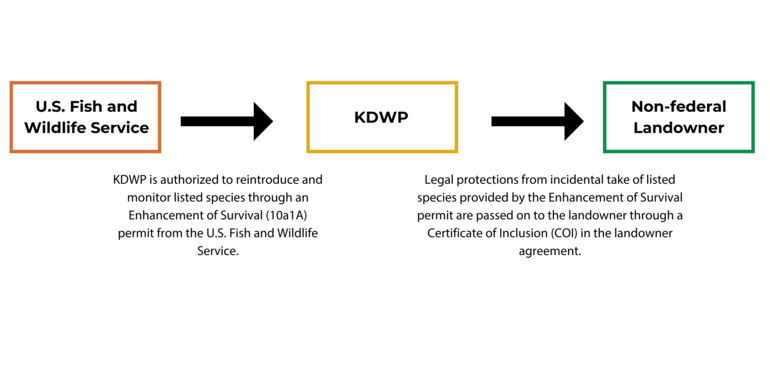Kansas Aquatic Species Recovery Program
Over half of the approximately 184 species of fish and freshwater mussels native to Kansas waters are listed as species of greatest conservation need. These species are identified by biologists as needing proactive conservation action. Of those species, 27 are listed as threatened or endangered by either the Endangered Species Act of 1973, the Kansas Nongame and Endangered Species Conservation Act, or both. The Aquatic Recovery Program seeks to recover, delist, and deregulate populations of these species by working with private landowners to reintroduce species back into Kansas waters in areas where they have gone locally extinct.
Species reintroductions are made possible through the Kansas Aquatic Species Conservation Agreement. This agreement is a Programmatic Safe Harbor and Candidate Conservation Agreement between KDWP and the U.S. Fish and Wildlife Service. The agreement provides regulatory protections to KDWP and allows the agency to conduct species reintroduction efforts for certain state or federally listed species. Kansas and North Carolina are the first states in the nation to enroll in a statewide programmatic agreement for aquatic species. These agreements provide new conservation tools for both states to pursue species recovery.
In Kansas, over 98% of land is privately owned. Consequently, species recovery will not occur without collaborating with conservation-minded property owners. Landowners with property containing adequate habitat that resides within the historical range of a target species can partner with KDWP to pursue species reintroductions. These voluntary partnerships are made possible through landowner agreements provided in the Kansas Aquatic Species Conservation Agreement. Partnering landowners agree to allow stocking of target species within waters on their property and allow KDWP biologists to conduct species surveys to assess reintroduced animal populations. In return, regulatory protections provided to KDWP are passed on to the landowner through landowner agreements. Incidental harm done to target species through otherwise lawful activities (such as habitat enhancement projects, farming, and or ranching) would be covered by a landowner agreement.
For more information on species reintroduction projects, click the individual species tabs at the side of the page. To date, KDWP has completed a re-introductory stocking for the Neosho Mucket, and are in the planning phases of an Alligator Snapping Turtle release.
- Participation in the program is completely voluntary.
- Property owners are not required to fulfill any additional activities outside of the agreement without their consent.
- No additional restrictions for the covered species on the use of the landowner’s land, water, or resources beyond those agreed upon will be imposed.
- Within the agreement, landowners can list any number of legal land-use activities they would like covered from incidental take to listed species. Examples include: farming, ranching, timber harvest, and levee repair. Habitat conservation actions such as riparian tree plantings, cattle exclusion fencing, and stream bank restoration could also be covered.
- Agreements do no hamper economic activities on the enrolled property.
- Agreements allow for flexible scheduling of species reintroductions and monitoring surveys between KDWP and the landowner.
- Terms, including scheduling, target species, and covered land use practices can be amended at any time.
- Landowner is not held responsible for changed circumstances leading to take or failure in species reintroductions such as drought, disease, and other natural disasters.
- Landowners can terminate the agreement at any time but must provide KDWP the opportunity to relocate stocked species within 60 days of notice.
- Neighboring landowner agreements are available to landowners who would like assurances from take of species but do not want KDWP to release or monitor species on their property.
A complete copy of the Kansas Aquatic Species Conservation Agreement can be found here:
To learn more about the Kansas Aquatic Species Recovery Program, contact Trevor Starks, Recovery Program Coordinator at trevor.starks@ks.gov or 785-480-0982.








